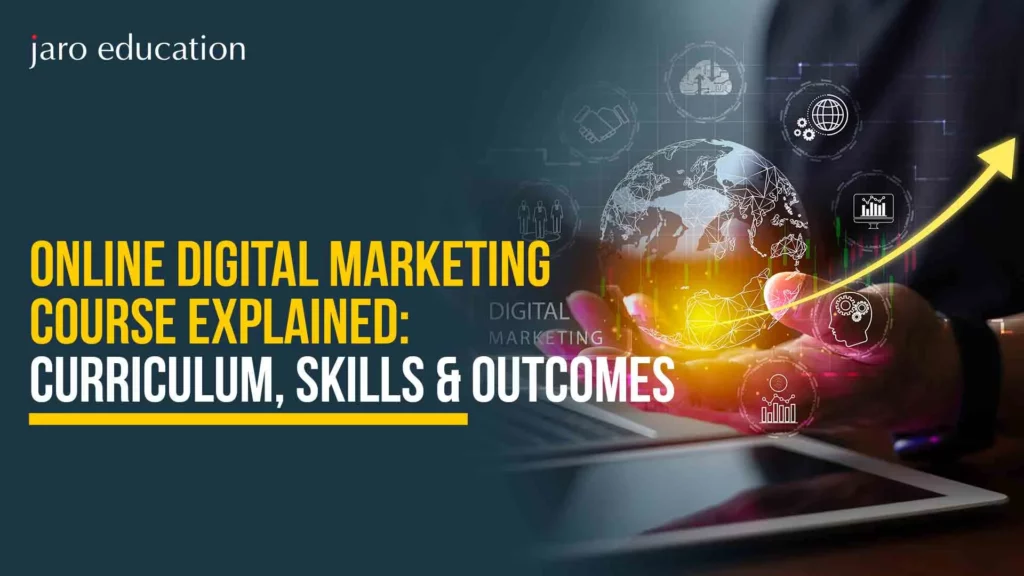Growth Marketing and its Components
Table of Contents

- jaro education
- 15, August 2023
- 3:00 pm
Growth marketing is the process of driving growth by utilising data obtained through marketing campaigns and experimentation. It can assist companies in anticipating change and planning their strategy for continuous development. Growth marketers continuously analyse data and receive feedback on what works and what doesn’t.
The world of digital product marketing appears to be continuously changing. Strategies that work one day may not work the next. They are being replaced by new tools, users and programmes. It’s easy to become overwhelmed by this change, but there’s another way to look at it.
As the field of digital marketing and growth marketing is growing fast, companies need better strategies to get new customers and retain them. So, if you are interested in gaining knowledge about growth marketing, consider taking a digital marketing certificate course. There are various universities which offer this course. The best programme for this field would be the Professional Certificate Programme in Digital Marketing for Performance & Growth from IIM Kozhikode. This programme offers overall marketing approaches you can utilise in live projects. To know about the details of this course, register with Jaro Education.
About growth marketing
It is a marketing optimisation technique that goes beyond product marketing to assist businesses in growing customer loyalty. This sort of marketing makes the most of your efforts by utilising techniques like data analysis, A/B testing, search engine optimisation (SEO), and email marketing to execute smarter, more successful growth tactics. Growth marketing minimises innovation cycles rather than depending on long-term initiatives. Just-in-time marketing and micro-campaigns address the demands of the present.
In growth marketing, “growth” means adding more users, acquiring name recognition, or even increasing income. The trick is to begin small and gather data on which marketing initiatives are most effective. Furthering the process, concentrate your efforts on the channels supported by the data. Finally, decide how much of your marketing budget to allocate to such activities.
Key components of growth marketing
Because growth marketing extends standard marketing tactics, it necessitates more work and considerations for how to enhance customer loyalty and persuade respective consumers to be their most ardent brand champions. The following are important components of growth marketing:
A/B Testing
With today’s digital marketing capabilities, one can evaluate the outcomes of various email campaigns, social media postings, and other marketing initiatives. To develop an A/B test, practically every piece of marketing material may be written in two ways.
For example, growth marketers may test two versions of a company’s email newsletter, one emphasising one feature of their product and the other on a different part. These various versions are the A and B of A/B testing.
In this situation, they would design each test email to be sent to a subset of the mailing list by splitting it in half or sending one version to a small sample. Along with that, as a growth marketer, one should also provide the measure or goal he hopes to achieve with the test.
In such instances, both sets benefit in different ways. For example, more individuals may click on the link in email A, but a larger percentage of customers may purchase after visiting the feature emphasised in email B. This is really useful information. It suggests that some consumers are more likely to complete a transaction and prefer email B.
This type of data can become part of a long-term continuous improvement plan in which growth marketers compare existing best tactics with new ideas. They need to know what’s been attempted previously to keep a note of the marketing progress.
All hands on deck tactic
Growth marketing cannot exist in a vacuum. Everyone in a company works towards the same objective of expansion. After all, everyone wants more people to interact with their product. That objective of expansion is carried out throughout the organisation, from product development to customer service. Every team has something to offer that can spark a fresh approach to attracting users.
In an organisation, the marketing team becomes a centre for combining and analysing data from other departments to help design the next batch of campaigns. But how teams other than marketing are gathering relevant marketing information time and again? Here is an overview.
-
- Analytics and developers monitor abnormally high or low online traffic, which might encourage marketing to experiment with new digital initiatives.
- Customer service is always in contact with people, and their dialogues are important to marketers. Customers compliment what works well (informing you of which aspects to promote) and express repeated problems (indicating areas to focus on and then remarket).
- Product development considers supplementary product lines, upgrades, and feature requests, and their future plans can be leveraged in marketing efforts.
Growth marketing may start with any data source that inspires innovation. Use the data to generate new tactics, and put them to the test with a pilot programme or an experiment to determine if they’re worth extending.
When you first start out with growth marketing, experiment with a few different strategies. Star with making little modifications to your newsletter, emails, or social media schedule. The thrill comes when you observe how these little adjustments affect your product engagement, downloads, or subscription renewals, revealing which new route will perform best.
Flexibility and Responsiveness
Responding swiftly to fresh possibilities is frequently required in growth marketing. To remain agile, plan brief campaigns giving considerable time to analyse the outcomes. The cycle may be longer or shorter depending on your firm, but it never takes too long to see visible results.
Growth marketing is adaptable. You cannot believe that the same type of advertisement or content will always be effective. Instead, you continue to attempt new things depending on the input provided by analytics and consumer surveys. There is some creativity in it, but it is a creative problem solution rather than an arbitrary chance.
Multi-channel marketing efforts
As previously said, marketing tactics should not live in isolation. They should collaborate to develop a plan and gain more devoted consumers. Creating a strategy that incorporates several channels, such as text (SMS) marketing, social media, direct mail, email marketing and others, will assist growth marketers in determining the best ways to raise their marketing efforts and increase their return on investment (ROI).
Being adaptable and testing different marketing methods allows companies to understand user behaviour better. For example, growth marketers may discover that email marketing has a greater clickthrough rate (CTR) but a lower response rate than push notifications. Based on this data, they may tailor your marketing activities and improve their success.
Customer feedback
There are several ways to analyse data using current digital marketing, such as Google Analytics. Marketers can also obtain an immediate response in the form of a link click or a like on a social networking platform.
Marketers create additional ways to connect with users to capture even more useful data. They try to go beyond the quantitative data obtained from a company’s website and reach out to acquire feedback on your product.
To combine engagement data with data-driven marketing, new methods of soliciting client input are required. Growth marketers may wish to keep track of website visitors who downloaded the app but haven’t yet registered or those who provided their email addresses to purchase a subscription but never finished the transaction.
They may design behaviour-based automation activated after a set period of time. These emails can elicit comments from your users about why they haven’t checked in or what queries they have about the membership they are going to purchase. After that, they use the data to gain insight into what prompted them to click “Order Now”.
Marketers may discover that the payment page is unclear or that they are unsure about the membership conditions. With this input, product development, customer service, and even engineers may all strive to improve the customer experience.
They might use this information to select what material to emphasise in the next campaign. Growth marketing teams can choose to send a welcome email to users immediately after they download your app to assist them with logging in. Alternatively, a page detailing all of the advantages of subscribing to a paying plan would be an excellent addition to the company website.
Implementing a successful growth marketing strategy
Growth marketing teams may use the following strategies to launch a successful growth marketing campaign:
- Gathering information about potential consumers and analysing any existing feedback.
- Creating a few simple A/B tests using the information the team has obtained.
- Designing and testing blogs, social media postings, podcasts, email campaigns and other content.
- Monitoring engagement metrics for test features.
- Examining what works well and incorporating such strategies into a growing library of customised best practices.
- Before beginning over, teams reach out to other teams for new data and input.
How growth marketing differs from traditional marketing?
Growth marketing, as opposed to top-down marketing, focuses on the complete customer experience and marketing funnel.
Traditional marketing may focus on brand recognition and client acquisition while ignoring what occurs once a prospect becomes a customer. On the other hand, growth marketing majorly focuses on the full marketing funnel, from brand recognition through retention and beyond. Traditional marketing’s purpose isn’t just to increase website traffic or raise awareness. Instead, it aims to capitalise on that awareness by converting visitors into customers through interaction and providing a positive customer experience that transforms consumers into brand ambassadors.

*Mighty
Examples of growth marketing
Here are a few variations of growth marketing that marketers currently utilise.
- Using email marketing to create brand loyalty by providing subscribers with unique incentives.
- Providing a high-quality product that is constantly improved in response to client input.
- Redesigning marketing campaigns based on A/B testing findings to boost conversion rates, enhance key performance indicators (KPIs) and lead generation.
- Growth marketing teams can contact customers where they spend their time using growth marketing.
Growth marketing enables teams to reach customers where they spend time, be it on the web, social media or email.
Using growth marketing as an advantage
A growth marketing strategy goes beyond standard marketing to improve customer connections, enhance loyalty, and encourage repeat purchases. Growth marketing should include a variety of marketing tactics, ranging from traditional marketing materials to your website, social media, and email marketing plan. This marketing style challenges you to learn about your clients by soliciting feedback on your product and service offerings. Customer feedback and A/B testing can help companies enhance their products and marketing activities.
Final Thoughts
A competent growth marketing team approaches everything in your organisation with a marketing perspective. Keep an eye out for ways to use feedback and data. Take advantage of every opportunity to examine your marketing strategy, modifying it for ever-increasing growth.
Growth marketing in India is becoming a budding career prospect, and many professionals are pursuing courses in this field. Of these courses, Professional Certificate Programme in Digital Marketing for Performance & Growth – IIM Kozhikode offers a complete package. This is a 9-month programme that encompasses key aspects of growth marketing tactics and strategies, in addition to content marketing, advertising and SEO, social media marketing, and more.












